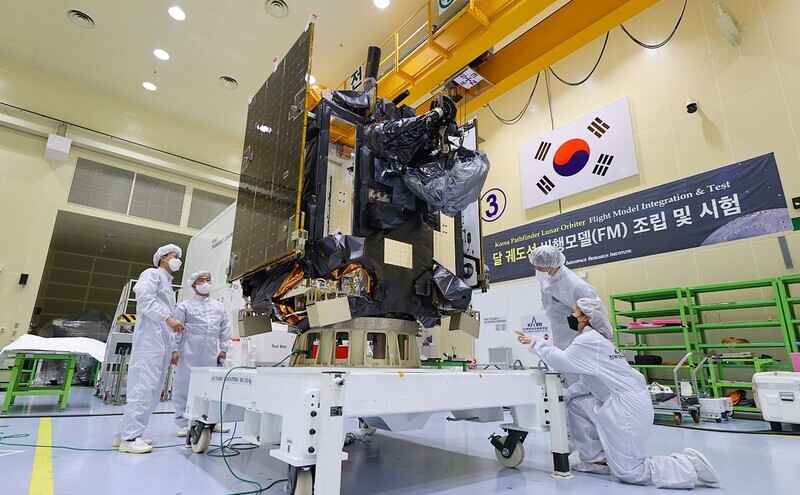hankyoreh
Links to other country sites 다른 나라 사이트 링크
After 4 more Nuri launches, S. Korea sets sights on next-gen lunar explorer by 2030

The successful second flight of the Nuri rocket Tuesday got South Korean space development off to a strong start as it prepares for the next three decades.
With this launch, South Korea becomes the 10th country to independently send its own launch vehicle into space and the seventh to acquire the capabilities to put a 1.5-metric ton satellite into orbit.
But in a strict sense, the initial Nuri launch last October and the second launch this week were just rehearsals.
On the ground, Tuesday’s takeoff was referred to as a “test launch,” meaning that it was a stage of checking whether the launch vehicle works properly as a means of transportation. The first Nuri launch involved only a dummy satellite, while the second included a 168-kilogram performance verification satellite and a 1.3-metric ton dummy satellite.
The real test to see whether Nuri can take the next leap in the aerospace industry will start next year. The South Korean launch vehicle advancement program, which is currently being managed by the Ministry of Science and ICT and the Korea Aerospace Research Institute (KARI), passed a pre-feasibility study last year, with plans for four additional Nuri launches through 2027 at a cost of 687.4 billion won.
The third Nuri launch next year will be the first to carry a satellite for actual operation, with the second next-generation small satellite.
“Assembly is currently underway for the third Nuri launch,” explained Jang Young-soon, head of KARI’s launcher system development team.
For its fourth launch, in 2024, Nuri is to carry the third next-generation mid-size satellite and the first microsatellite. The fifth and sixth launches are to include five microsatellites each in 2025 and 2027, respectively.
The ministry is also working on a “next-generation launch vehicle” development project to follow the Nuri. This is in response to the limited ability of Nuri to execute all of the elements in the third master plan for space development promotion, including independent launches of a lunar lander and a 3-metric ton satellite.
If the project passes its pre-feasibility study in its current form, development will begin next year on a two-stage liquid oxygen/kerosene-based launch vehicle over a nine-year period through 2031 at a cost of 1.933 trillion won, or roughly US$1.5 billion.
A single-stage engine has a clustering design connecting five 100-metric ton liquid-propellant engines that are larger than the Nuri’s engine (75 metric tons), while a two-stage engine consists of two 10-metric ton liquid-propellant engines. KARI began preliminary research this year on boosting liquid propellant engine performance, acquiring the core technology for a 100-metric ton staged combustion cycle engine.
The plan would also have the next-generation launch vehicle used for a lunar probe to be launched around 2030.
On Aug. 3 (Korea time), South Korea’s first lunar orbiter is scheduled to be launched on board SpaceX’s Falcon 9 from the Cape Canaveral Space Force Station in Florida. The lunar orbiter’s launch is seen as a potential turning point in South Korea’s development as a space power, as it would signify success in all three of the major areas of space development, including launch vehicle and satellite development.
By Lee Keun-young, senior staff writer
Please direct questions or comments to [english@hani.co.kr]

Editorial・opinion
![[Column] Season 2 of special prosecutor probe may be coming to Korea soon [Column] Season 2 of special prosecutor probe may be coming to Korea soon](https://flexible.img.hani.co.kr/flexible/normal/500/300/imgdb/original/2024/0426/3317141030699447.jpg) [Column] Season 2 of special prosecutor probe may be coming to Korea soon
[Column] Season 2 of special prosecutor probe may be coming to Korea soon![[Column] Park Geun-hye déjà vu in Yoon Suk-yeol [Column] Park Geun-hye déjà vu in Yoon Suk-yeol](https://flexible.img.hani.co.kr/flexible/normal/500/300/imgdb/original/2024/0424/651713945113788.jpg) [Column] Park Geun-hye déjà vu in Yoon Suk-yeol
[Column] Park Geun-hye déjà vu in Yoon Suk-yeol- [Editorial] New weight of N. Korea’s nuclear threats makes dialogue all the more urgent
- [Guest essay] The real reason Korea’s new right wants to dub Rhee a founding father
- [Column] ‘Choson’: Is it time we start referring to N. Korea in its own terms?
- [Editorial] Japan’s rewriting of history with Korea has gone too far
- [Column] The president’s questionable capacity for dialogue
- [Column] Are chaebol firms just pizza pies for families to divvy up as they please?
- [Column] Has Korea, too, crossed the Rubicon on China?
- [Correspondent’s column] In Japan’s alliance with US, echoes of its past alliances with UK
Most viewed articles
- 1AI is catching up with humans at a ‘shocking’ rate
- 2Korea’s 1.3% growth in Q1 signals ‘textbook’ return to growth, says government
- 3Is Japan about to snatch control of Line messenger from Korea’s Naver?
- 4After election rout, Yoon’s left with 3 choices for dealing with the opposition
- 5No good, very bad game for Korea puts it out of Olympics for first time since 1988
- 6Will NewJeans end up collateral damage in internal feud at K-pop juggernaut Hybe?
- 7[Column] Season 2 of special prosecutor probe may be coming to Korea soon
- 81 in 5 unwed Korean women want child-free life, study shows
- 9[Column] Park Geun-hye déjà vu in Yoon Suk-yeol
- 10‘We must say no’: Seoul defense chief on Korean, USFK involvement in hypothetical Taiwan crisis